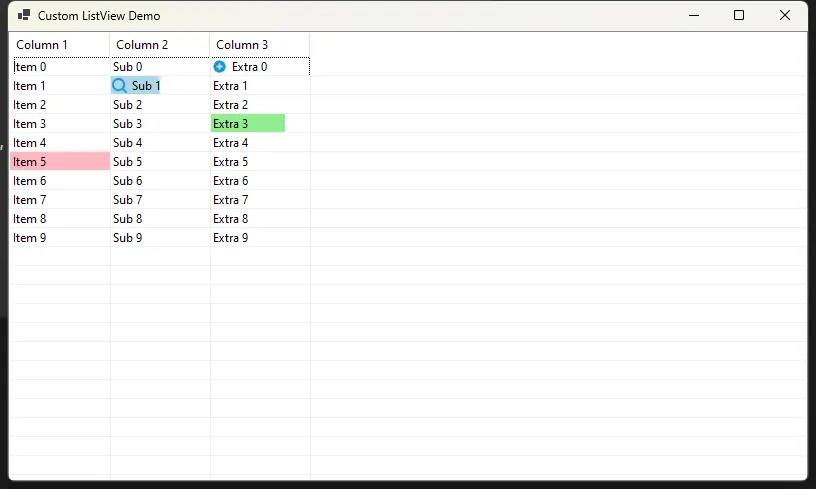目录
简介
ColorListView 是一个继承自 ListView 的自定义控件,它提供了更丰富的单元格样式设置功能。这个控件允许用户为每个单元格设置自定义的背景颜色、填充百分比和图标。通过重写绘制方法,ColorListView 实现了这些自定义功能,同时保留了原有 ListView 的基本特性。
主要特性
- 自定义单元格背景颜色
- 可调节的背景填充百分比
- 支持为单元格添加自定义图标
- 保留原有的选中和焦点状态显示
实现细节
CellInfo 类
CellInfo 是一个私有内部类,用于存储每个单元格的自定义信息:
C#private class CellInfo
{
public Color BackColor { get; set; }
public float FillPercentage { get; set; }
public Image Icon { get; set; }
public CellInfo(Color backColor, float fillPercentage, Image icon = null)
{
BackColor = backColor;
FillPercentage = Math.Max(0, Math.Min(100, fillPercentage)) / 100f;
Icon = icon;
}
}
这个类封装了单元格的背景颜色、填充百分比和图标信息。
自定义信息存储
控件使用一个字典来存储每个单元格的自定义信息:
C#private Dictionary<Point, CellInfo> customCellInfo;
字典的键是一个 Point 对象,表示单元格的列索引和行索引。
初始化
在构造函数中,控件进行了必要的初始化:
C#public ColorListView()
{
customCellInfo = new Dictionary<Point, CellInfo>();
this.OwnerDraw = true;
SetStyle(ControlStyles.DoubleBuffer | ControlStyles.OptimizedDoubleBuffer | ControlStyles.AllPaintingInWmPaint, true);
UpdateStyles();
}
这里启用了自定义绘制和双缓冲,以提高绘制性能和减少闪烁。
设置单元格样式
控件提供了两个公共方法来设置单元格样式:
C#public void SetCellBackColor(int rowIndex, int columnIndex, Color color, float fillPercentage = 100)
{
// 实现代码...
}
public void SetCellIcon(int rowIndex, int columnIndex, Image icon)
{
// 实现代码...
}
这些方法允许用户为指定的单元格设置背景颜色、填充百分比和图标。
自定义绘制
控件重写了 OnDrawItem 和 OnDrawColumnHeader 方法来实现自定义绘制:
C#protected override void OnDrawColumnHeader(DrawListViewColumnHeaderEventArgs e)
{
e.DrawDefault = true;
}
protected override void OnDrawItem(DrawListViewItemEventArgs e)
{
// 实现代码...
}
OnDrawItem 方法负责绘制每一行,而具体的单元格绘制则由 DrawSubItem 私有方法完成。
单元格绘制
DrawSubItem 方法是实现自定义绘制的核心:
C#private void DrawSubItem(Graphics g, ListViewItem item, int columnIndex, bool isSelected)
{
// 实现代码...
}
这个方法处理了以下几个方面:
- 绘制自定义背景色和填充
- 绘制图标(如果有)
- 绘制文本
- 处理选中状态
辅助方法
GetSubItemBounds 方法用于计算每个子项的边界矩形,这对于正确定位绘制内容非常重要:
C#private Rectangle GetSubItemBounds(ListViewItem item, int subItemIndex)
{
// 实现代码...
}
完整代码
C#using System;
using System.Collections.Generic;
using System.Drawing;
using System.Windows.Forms;
public class ColorListView : ListView
{
private class CellInfo
{
public Color BackColor { get; set; }
public float FillPercentage { get; set; }
public Image Icon { get; set; }
public CellInfo(Color backColor, float fillPercentage, Image icon = null)
{
BackColor = backColor;
FillPercentage = Math.Max(0, Math.Min(100, fillPercentage)) / 100f;
Icon = icon;
}
}
private Dictionary<Point, CellInfo> customCellInfo;
public ColorListView()
{
customCellInfo = new Dictionary<Point, CellInfo>();
this.OwnerDraw = true;
SetStyle(ControlStyles.DoubleBuffer | ControlStyles.OptimizedDoubleBuffer | ControlStyles.AllPaintingInWmPaint, true);
UpdateStyles();
}
public void SetCellBackColor(int rowIndex, int columnIndex, Color color, float fillPercentage = 100)
{
Point key = new Point(columnIndex, rowIndex);
if (customCellInfo.TryGetValue(key, out CellInfo info))
{
info.BackColor = color;
info.FillPercentage = fillPercentage / 100f;
}
else
{
customCellInfo[key] = new CellInfo(color, fillPercentage);
}
Invalidate();
}
public void SetCellIcon(int rowIndex, int columnIndex, Image icon)
{
Point key = new Point(columnIndex, rowIndex);
if (customCellInfo.TryGetValue(key, out CellInfo info))
{
info.Icon = icon;
}
else
{
customCellInfo[key] = new CellInfo(Color.Transparent, 0, icon);
}
Invalidate();
}
protected override void OnDrawColumnHeader(DrawListViewColumnHeaderEventArgs e)
{
e.DrawDefault = true;
}
protected override void OnDrawItem(DrawListViewItemEventArgs e)
{
e.DrawDefault = false;
if (e.Item.Selected)
{
using (SolidBrush brush = new SolidBrush(SystemColors.Highlight))
{
e.Graphics.FillRectangle(brush, e.Bounds);
}
}
else
{
e.DrawBackground();
}
for (int i = 0; i < this.Columns.Count; i++)
{
DrawSubItem(e.Graphics, e.Item, i, e.Item.Selected);
}
if ((e.State & ListViewItemStates.Focused) != 0)
{
e.DrawFocusRectangle();
}
}
private void DrawSubItem(Graphics g, ListViewItem item, int columnIndex, bool isSelected)
{
Rectangle bounds = GetSubItemBounds(item, columnIndex);
Point cellKey = new Point(columnIndex, item.Index);
if (customCellInfo.TryGetValue(cellKey, out CellInfo customInfo) && !isSelected)
{
int fillWidth = (int)(bounds.Width * customInfo.FillPercentage);
Rectangle fillRect = new Rectangle(bounds.X, bounds.Y, fillWidth, bounds.Height);
using (SolidBrush brush = new SolidBrush(customInfo.BackColor))
{
g.FillRectangle(brush, fillRect);
}
}
string text = columnIndex == 0 ? item.Text : item.SubItems[columnIndex].Text;
Color textColor = isSelected ? SystemColors.HighlightText : item.ForeColor;
// Draw icon if exists
if (customInfo != null && customInfo.Icon != null)
{
int iconSize = bounds.Height - 4; // Leave some padding
Rectangle iconRect = new Rectangle(bounds.X + 2, bounds.Y + 2, iconSize, iconSize);
g.DrawImage(customInfo.Icon, iconRect);
bounds.X += iconSize + 4; // Move text to the right of the icon
bounds.Width -= iconSize + 4;
}
TextRenderer.DrawText(g, text, this.Font, bounds, textColor, TextFormatFlags.Left | TextFormatFlags.VerticalCenter);
}
private Rectangle GetSubItemBounds(ListViewItem item, int subItemIndex)
{
if (item == null)
throw new ArgumentNullException("item");
Rectangle subItemRect = Rectangle.Empty;
if (subItemIndex >= 0 && subItemIndex < this.Columns.Count)
{
Rectangle lviBounds = item.GetBounds(ItemBoundsPortion.Entire);
int subItemX = lviBounds.Left;
for (int i = 0; i < subItemIndex; i++)
subItemX += this.Columns[i].Width;
subItemRect = new Rectangle(subItemX, lviBounds.Top, this.Columns[subItemIndex].Width, lviBounds.Height);
}
return subItemRect;
}
}
使用示例
以下是如何使用 ColorListView 的简单示例:
C#public partial class Form1 : Form
{
private ColorListView customListView;
public Form1()
{
InitializeComponent();
customListView = new ColorListView();
// 设置 CustomListView 属性
this.customListView.Dock = DockStyle.Fill;
this.customListView.View = View.Details;
this.customListView.FullRowSelect = true;
this.customListView.GridLines = true;
// 添加列
this.customListView.Columns.Add("Column 1", 100);
this.customListView.Columns.Add("Column 2", 100);
this.customListView.Columns.Add("Column 3", 100);
// 添加一些测试数据
for (int i = 0; i < 10; i++)
{
ListViewItem item = new ListViewItem(new string[] { $"Item {i}", $"Sub {i}", $"Extra {i}" });
this.customListView.Items.Add(item);
}
// 设置一些单元格的自定义背景色
this.customListView.SetCellBackColor(1, 1, Color.LightBlue, 50); // 50% 填充
this.customListView.SetCellBackColor(3, 2, Color.LightGreen, 75); // 75% 填充
this.customListView.SetCellBackColor(5, 0, Color.LightPink, 100); // 100% 填充(默认)
Image icon1 = Image.FromFile("add.png");
customListView.SetCellIcon(0, 2, icon1);
Image icon2 = Image.FromFile("search.png");
customListView.SetCellIcon(1, 1, icon2);
this.Controls.Add(this.customListView);
this.Name = "MainForm";
this.Text = "Custom ListView Demo";
}
}

结论
ColorListView 通过继承和自定义绘制,扩展了标准 ListView 控件的功能。它提供了更灵活的单元格样式设置选项,同时保持了良好的性能和原有的基本功能。这个控件特别适用于需要在列表中展示更丰富视觉信息的应用场景。
本文作者:rick
本文链接:
版权声明:本博客所有文章除特别声明外,均采用 BY-NC-SA 许可协议。转载请注明出处!